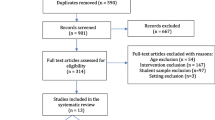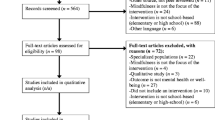Abstract
There is a growing interest in the use of mindfulness-based interventions (MBI) on youth, which has recently expanded to include the study of students in school settings. This article systematically reviewed the existing literature of applied studies using MBI with students in school settings in order to identify limitations in the scientific literature and inform future research directions. Twenty-eight studies were selected for review and were coded across multiple domains, including methodologies employed, student characteristics, intervention characteristics, and outcome variables. Results quantitatively summarized the coded variables, and strengths and limitations in the literature were subsequently identified. We conclude with specific recommendations for future interventions scientists wishing to study the utility of MBI in school settings.
Similar content being viewed by others
References
*References marked with an asterisk indicate studies included in the systematic review
Baer, R. (2014). Mindfulness-based treatment approaches: Clinician’s guide to evidence base and applications (2nd ed.). NY: Academic.
*Barnes, V. A., Pendergrast, R. A., Harshfield, G. A., & Treiber, F. A. (2008). Impact of breathing awareness meditation on ambulatory blood pressure and sodium handling in prehypertensive African American adolescents. Ethnicity & Disease, 18, 1–5.
*Beauchemin, J., Hutchins, T. L., & Patterson, F. (2008). Mindfulness meditation may lessen anxiety, promote social skills, and improve academic performance among adolescents with learning disabilities. Complementary Health Practice Review, 13, 34–45.
*Bei, B., Byrne, M. L., Ivens, C., Waloszek, J., Woods, M. J., Dudgeon, P., & Allen, N. B. (2013). Pilot study of a mindfulness‐based, multi‐component, in‐school group sleep intervention in adolescent girls. Early Intervention in Psychiatry, 7, 213–220.
Bishop, S. R., Lau, M., Shapiro, S., Carlson, L., Anderson, N. D., Carmody, J., & Devins, G. (2004). Mindfulness: A proposed operational definition. Clinical psychology: Science and practice, 11, 230–241.
*Black, D. S., & Fernando, R. (2014). Mindfulness training and classroom behavior among lower-income and ethnic minority elementary school children. Journal of Child and Family Studies.
*Britton, W. B., Lepp, N. E., Niles, H. F., Rocha, T., Fisher, N. E., & Gold, J. S. (2014). A randomized controlled pilot trial of classroom-based mindfulness meditation compared to an active control condition in sixth-grade children. Journal of School Psychology.
Broderick, P. C. (2013). Learning to BREATHE: a mindfulness curriculum for adolescents. Oakland: New Harbinger.
*Broderick, P. C., & Metz, S. (2009). Learning to BREATHE: a pilot trial of a mindfulness curriculum for adolescents. Advances in School Mental Health Promotion, 2, 35–46.
Brown, K. W., Ryan, R. M., & Creswell, J. D. (2007). Mindfulness: theoretical foundations and evidence for its salutary effects. Psychological Inquiry, 18, 211–237.
Burke, C. A. (2010). Mindfulness-based approaches with children and adolescents: a preliminary review of current research in an emergent field. Journal of Child and Family Studies, 19, 133–144.
*Carboni, J. A., Roach, A. T., & Fredrick, L. D. (2013). Impact of mindfulness training on the behavior of elementary students with attention-deficit/hyperactive disorder. Research in Human Development, 10(3), 234–251.
Cook, D. T. (2002). Randomized experiments in educational policy research: a critical examination of the reasons the educational evaluation community has offered for not doing them. Educational Evaluation and Policy Analysis, 24, 175–199.
Feagans-Gould, L., Dariotis, J. K., Greenberg, M. T., & Mendelsona, T. (2015). Assessing fidelity of implementation (FOI) for school-based mindfulness and yoga interventions: a systematic review of the literature. Mindfulness.
Felver, J. C., Doerner, E., Jones, J., Kaye, N. C., & Merrell, K. W. (2013). Mindfulness in school psychology: applications for intervention and professional practice. Psychology in the Schools, 50, 531–547.
*Felver, J. C., Frank, J. L., & McEachern, A. D. (2014). Effectiveness, acceptability, and feasibility of the Soles of the Feet mindfulness-based intervention with elementary school students. Mindfulness.
Felver, J. C., Butzer, B., Olson, K., Smith, I., & Khalsa, S. B. (2014). Effects of a school-based yoga curriculum on mood state. Contemporary School Psychology.
*Flook, L., Smalley, S. L., Kitil, M. J., Galla, B. M., Kaiser-Greenland, S., Locke, J., & Kasari, C. (2010). Effects of mindful awareness practices on executive functions in elementary school children. Journal of Applied School Psychology, 26, 70–95.
Garrison Institute. (2005). Contemplation and education: a survey of programs using contemplative techniques in K-12 educational settings: a mapping report. New York: Author.
Greenberg, M. T., & Harris, A. R. (2012). Nurturing mindfulness in children and youth: current state of research. Child Development Perspectives, 6, 161–166.
*Gregoski, M. J., Barnes, V. A., Tingen, M. S., Harshfield, G. A., & Treiber, F. A. (2011). Breathing awareness meditation and lifeskills training programs influence upon ambulatory blood pressure and sodium excretion among African American adolescents. Journal of Adolescent Health, 48, 59–64.
Hayes, S. C., Strosahl, K., & Wilson, K. G. (1999). Acceptance and commitment therapy: an experiential approach to behavior change. New York: Guilford Press.
*Huppert, F. A., & Johnson, D. M. (2010). A controlled trial of mindfulness training in schools: the importance of practice for an impact on well-being. The Journal of Positive Psychology, 5, 264–274.
*Joyce, A., Etty-Leal, J., Zazryn, T., & Hamilton, A. (2010). Exploring a mindfulness meditation program on the mental health of upper primary children: a pilot study. Advances in School Mental Health Promotion, 3, 17–25.
Kabat-Zinn, J. (1990). Full catastrophe living: using the wisdom of your body and mind to face stress, pain, and illness. New York: Delacourt.
Khoury, B., Lecomte, T., Fortin, G., Masse, M., Therien, P., Bouchard, V., & Hofmann, S. G. (2013). Mindfulness-based therapy: a comprehensive meta-analysis. Clinical Psychology Review, 33, 763–771.
*Klatt, M., Harpster, K., Browne, E., White, S., & Case-Smith, J. (2013). Feasibility and preliminary outcomes for move-into-learning: an arts-based mindfulness classroom intervention. The Journal of Positive Psychology, 8, 233–241.
Kutash, K., Banks, S., Duchnowski, A., & Lynn, N. (2007). Implications of nested designs in school-based mental health services research. Evaluation and Program Planning, 30, 161–171.
*Kuyken, W., Weare, K., Ukoumunne, O. C., Vicary, R., Motton, N., Burnett, R., & Huppert, F. (2013). Effectiveness of the mindfulness in schools programme: non-randomised controlled feasibility study. The British Journal of Psychiatry, 203, 126–131.
*Lagor, A. F., Williams, D. J., Lerner, J. B., & McClure, K. S. (2013). Lessons learned from a mindfulness-based intervention with chronically ill youth. Clinical Practice in Pediatric Psychology, 1, 146.
*Lau, N. S., & Hue, M. T. (2011). Preliminary outcomes of a mindfulness-based programme for Hong Kong adolescents in schools: well-being, stress and depressive symptoms. International Journal of Children’s Spirituality, 16, 315–330.
*Liehr, P., & Diaz, N. (2010). A pilot study examining the effect of mindfulness on depression and anxiety for minority children. Archives of Psychiatric Nursing, 24, 69–71.
Linehan, M. M., Armstrong, H. E., Suarez, A., Allmon, D., & Heard, H. L. (1991). Cognitive-behavioral treatment of chronically parasuicidal borderline patients. Archives of General Psychiatry, 48, 1060–1064.
Meiklejohn, J., Phillips, C., Freedman, M. L., Griffin, M. L., Biegel, G., Roach, A., & Saltzman, A. (2012). Integrating mindfulness training into K-12 education: fostering the resilience of teachers and students. Mindfulness, 3, 291–307.
*Mendelson, T., Greenberg, M. T., Dariotis, J. K., Gould, L. F., Rhoades, B. L., & Leaf, P. J. (2010). Feasibility and preliminary outcomes of a school-based mindfulness intervention for urban youth. Journal of Abnormal Child Psychology, 38, 985–994.
Merrell, K. W. (2003). Behavioral, social, and emotional assessment of children and adolescents (2nd ed.). Mahwah: Erlbaum.
*Metz, S. M., Frank, J. L., Reibel, D., Cantrell, T., Sanders, R., & Broderick, P. C. (2013). The effectiveness of the Learning to BREATHE program on adolescent emotion regulation. Research in Human Development, 10, 252–272.
Mind and Life Education Research Network. (2012). Contemplative practices and mental training: prospects for American education. Child Development Perspectives, 6, 146–153.
Mindful Schools. (2012). Website at www.mindfulschools.org.
*Napoli, M., Krech, P. R., & Holley, L. C. (2005). Mindfulness training for elementary school students: the attention academy. Journal of Applied School Psychology, 21, 99–125.
Noggle, J. J., Steiner, N. J., Minami, T., & Khalsa, S. B. (2012). Benefits of yoga for psychosocial well-being in a US high school curriculum: a preliminary randomized controlled trial. Journal of Developmental and Behavioral Pediatrics, 33, 193–201.
*Ricard, R. J., Lerma, E., & Heard, C. C. (2013). Piloting a dialectical Behavioral Therapy (DBT) infused skills group in a Disciplinary Alternative Education Program (DAEP). The Journal for Specialists in Group Work, 38, 285–306.
Roth, H. (2014). A pedagogy for the new field of contemplative studies. In I. Gunnlaugson, E. W. Sarath, C. Scott, & H. Bai (Eds.), Contemplative approaches to learning and inquiry across disciplines. Albany: SUNY Press.
*Schonert-Reichl, K. A., & Lawlor, M. S. (2010). The effects of a mindfulness-based education program on pre-and early adolescents’ well-being and social and emotional competence. Mindfulness, 1, 137–151.
Segal, Z. V., Williams, J. M. G., & Teasdale, J. D. (2002). Mindfulness-based cognitive therapy for depression—a new approach to preventing relapse. New York: Guilford Press.
*Sibinga, E., Perry-Parrish, C., Chung, S. E., Johnson, S. B., Smith, M., & Ellen, J. M. (2013). School-based mindfulness instruction for urban male youth: a small randomized controlled trial. Preventive Medicine, 57, 799–801.
Singh, N. N., Wahler, R. G., Winton, Adkins, A. D., Myers, R. E., & The Mindfulness Research Group. (2003). Soles of the feet: a mindfulness-based self-control intervention for aggression by an individual with mild mental retardation and mental illness. Research in Developmental Disabilities, 24, 158–169.
*Singh, N. N., Lancioni, G. E., Joy, S. D. S., Winton, A. S., Sabaawi, M., Wahler, R. G., & Singh, J. (2007). Adolescents with conduct disorder can be mindful of their aggressive behavior. Journal of Emotional and Behavioral Disorders, 15, 56–63.
*Viafora, D. P., Mathiesen, S. G., & Unsworth, S. J. (2014). Teaching mindfulness to middle school students and homeless youth in school classrooms. Journal of Child and Family Studies.
*White, L. S. (2012). Reducing stress in school-age girls through mindful yoga. Journal of Pediatric Health Care, 26, 45–56.
*Wisner, B. L., & Norton, C. L. (2013). Capitalizing on behavioral and emotional strengths of alternative high school students through group counseling to promote mindfulness skills. The Journal for Specialists in Group Work, 38, 207–224.
*Wright, L. B., Gregoski, M. J., Tingen, M. S., Barnes, V. A., & Treiber, F. A. (2011). Impact of stress reduction interventions on hostility and ambulatory systolic blood pressure in African American adolescents. Journal of Black Psychology, 37, 210–233.
Zoogman, S., Goldberg, S. B., Hoyt, W. T., & Miller, L. (2014). Mindfulness interventions with youth: a meta-analysis. Mindfulness.
Acknowledgments
The authors have no conflict of interest to report.
Author information
Authors and Affiliations
Corresponding author
Rights and permissions
About this article
Cite this article
Felver, J.C., Celis-de Hoyos, C.E., Tezanos, K. et al. A Systematic Review of Mindfulness-Based Interventions for Youth in School Settings. Mindfulness 7, 34–45 (2016). https://doi.org/10.1007/s12671-015-0389-4
Published:
Issue Date:
DOI: https://doi.org/10.1007/s12671-015-0389-4




